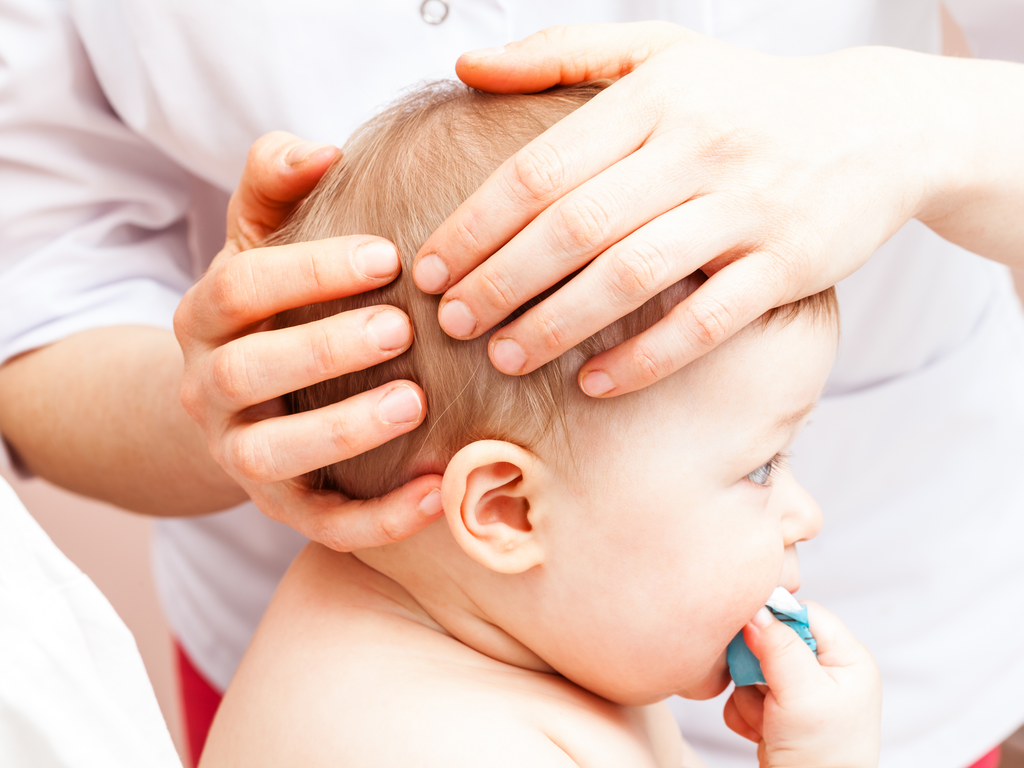
What is a Soft Spot?
Babies are born with flexible skulls that allow them to pass through the birth canal. At birth, the four upper plates in the skull and the single one at the back, known as the occipital bone, are connected by flexible ligaments called sutures. These allow the head to grow as the brain grows inside, which it does rapidly in early life. At the ‘corners’ of the bones, where three or more meet, there is a more open area called a fontanelle, otherwise known as a soft spot. Most people know about the one at the central front of the head, the anterior fontanelle, but there are actually six in the upper part of the head when the baby is born. Two on each side at the lower part of the skull, one at the back above the occipital bone, and the one that most people know about, the anterior fontanelle at the top front. We break down the different things to be aware of when it comes to your baby’s soft spot, aiming to answer questions such as how long do babies have soft spots?
When Should a Baby’s Soft Spot Close?
Many parents ask, when does the soft spot close? A baby’s fontanelles close at different times. The four at the lower side close at around three to six months of age, the posterior fontanelle at six to twelve months of age, and the anterior soft spot closes between 6 and 18 months of age.

The anterior soft spot can be felt as a flexible and springy area at the top front of the head. You can feel it by using light finger pressure to test it. Don’t worry, there is a tough flexible membrane between the skull bones. Some babies have quite large soft spots and some have very small ones, the difference in size is not unusual at all and is nothing to worry about. As the baby gets older the fontanelles gradually become smaller and eventually close. This doesn’t mean that your baby’s head has finished growing, it just means that the bones are becoming firmer and more protective of the brain. The sutures between the skull plates have to remain flexible throughout childhood to allow the brain and facial structures to grow and develop. So the fact that you can feel (or using the medical term, palpate) the soft spot is natural and nothing to worry about.
The soft spot can offer important clues into your baby’s health so keeping an eye on your baby’s soft spot will allow you to recognise these signs:
Baby’s Soft Spot Moving
Pulsating fontanelles aren’t a medical or health indication, and instead, represent a healthy blood flow in the brain. This pulse is absolutely normal and shows ‘brain pump’ around that area. Because there is no skull underneath the soft spot, your baby’s soft spot can be seen to move as a result of blood flow.
Sunken Fontanelles
Sunken fontanelles can be a sign of dehydration. If you do notice that your baby has a sunken fontanelle, you should just take notice and think about whether your baby has had enough fluid, particularly in hot weather. However, while a sunken fontanelle can occur when your baby is severely dehydrated, there are many other signs of dehydration that happen before a fontanelle becomes sunken, such as fewer wet nappies and being less alert and responsive. This can also sometimes happen if your baby is not feeding well, has diarrhoea, or is vomiting and not taking in enough fluid. If these are the case, take your baby to the doctor. So, a sunken soft spot is an indicator of concern but not a concern in its own right.
Bulging Fontanelles
Bulging Fontanelles can indicate serious illness. The bulge can be a sign of brain swelling and so is considered to be a medical emergency. Common medical causes of a bulging soft spot are brain inflammation (encephalitis) caused by a viral or bacterial infection; hydrocephalus which is excess fluid within the brain or skull and can be present at birth or develop in the early weeks; meningitis, which is the inflammation of brain or spinal cord tissue as a result of a viral or bacterial infection. These are the main concerns but there are also several other causes of swelling of the fontanelle and all should be investigated urgently. If you do notice a tense, bulging soft spot, it is extremely important that you seek medical help for your baby.
Does a Baby’s Soft Spot Affect Their Overall Head Shape?
Babies’ soft spots allow for a flexibility that gives the head and brain room to grow after birth. Because of this, a baby’s head shape will change before all of the sutures in their skull have fused together. Babies are often born with a birth moulding as a result of fitting through the birth canal, but this should correct itself during the first few days of life. To encourage the development of a normal head shape, parents can try repositioning techniques.
In cases where the head shape does not begin to correct, helmet treatment can help the process. Working alongside a baby’s natural head growth, helmet treatment can guide a baby’s head towards growth in the right areas. This relies on the softness of a baby’s skull.
A baby’s head shape has fully developed when the sutures in their head have closed. Although soft spots remain flexible throughout childhood, it is no longer possible to mould a baby’s head after their soft spot has closed.

Soft spots are completely normal and necessary for a baby’s head to grow naturally. Parents needn’t be worried about their baby’s soft spot in the majority of cases. However, keep an eye out for the tell-tale signs that your baby’s soft spot may be trying to tell you.
If you are worried about your baby’s head shape and think they may require helmet treatment, book a free pre-assessment at your nearest clinic.


